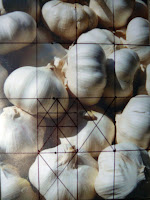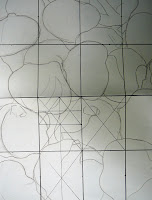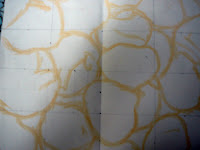Over the past few years, I have taught many beginning artists in various workshops. I have found that one of the most difficult and frightening aspects of starting a painting is the drawing. For most of us, being confident in the initial drawing is critical to how we will feel about our work at completion. So in teaching a workshop (whether it be watercolor or beginning in pastel), I just can't get around the first class: where to start with a drawing and how to design and craft a painting. Over the next few blog entries, I thought it would be helpful to post a few tips I follow that will help beginning artists be more successful in their paintings.

For students who have never drawn, creating a grid is one useful way to help you determine size, angle, and foreshortened relationships and perspective. If working from a reference, your first step will be to find the right proportion for your enlarged sketch (grid). I do this by laying the reference to the lower left corner of piece of sketch paper (large enough to fit your working surface). Draw a diagonal from the lower left corner to the top right corner. Any place on this diagonal that you draw 2 perpendicular lines, the rectangle will be proportional to your reference. This is the area you will use as your format for the larger painting and the area that will correspond to your grid.

Admittedly, there are many ways to make a grid. I will typically divide the paper and reference in half, 1/4 point and 3/4 point both vertically and
horizontally. The one rule... the grid should be the same in both your reference and your enlarged paper. You can further divide you grid as many times as necessary. My goal here is to simply create an
accurate line drawing to work from while painting. I will often revise my drawing as I go to fit what works for the painting. Most of the drawing is done with value and form in pastel. However, if my initial proportions are off, then I will never be able to accomplish what I want with value and form. Tip: I will place my reference in a sheet protector and create the grid on the plastic with a sharpie. This way, I can take the photo out later and see it without the distraction from the grid.

Once I have a drawing I am confident in, I will turn the paper over, cover the lines with graphite (for a watercolor) or hard pastel. Then I will lay the sketch paper over my painting surface (pastel side down) and retrace my initial sketch. Only the pastel sketch will be left on the surface and I am ready to start, almost...
 For students who have never drawn, creating a grid is one useful way to help you determine size, angle, and foreshortened relationships and perspective. If working from a reference, your first step will be to find the right proportion for your enlarged sketch (grid). I do this by laying the reference to the lower left corner of piece of sketch paper (large enough to fit your working surface). Draw a diagonal from the lower left corner to the top right corner. Any place on this diagonal that you draw 2 perpendicular lines, the rectangle will be proportional to your reference. This is the area you will use as your format for the larger painting and the area that will correspond to your grid.
For students who have never drawn, creating a grid is one useful way to help you determine size, angle, and foreshortened relationships and perspective. If working from a reference, your first step will be to find the right proportion for your enlarged sketch (grid). I do this by laying the reference to the lower left corner of piece of sketch paper (large enough to fit your working surface). Draw a diagonal from the lower left corner to the top right corner. Any place on this diagonal that you draw 2 perpendicular lines, the rectangle will be proportional to your reference. This is the area you will use as your format for the larger painting and the area that will correspond to your grid. Admittedly, there are many ways to make a grid. I will typically divide the paper and reference in half, 1/4 point and 3/4 point both vertically and horizontally. The one rule... the grid should be the same in both your reference and your enlarged paper. You can further divide you grid as many times as necessary. My goal here is to simply create an accurate line drawing to work from while painting. I will often revise my drawing as I go to fit what works for the painting. Most of the drawing is done with value and form in pastel. However, if my initial proportions are off, then I will never be able to accomplish what I want with value and form. Tip: I will place my reference in a sheet protector and create the grid on the plastic with a sharpie. This way, I can take the photo out later and see it without the distraction from the grid.
Admittedly, there are many ways to make a grid. I will typically divide the paper and reference in half, 1/4 point and 3/4 point both vertically and horizontally. The one rule... the grid should be the same in both your reference and your enlarged paper. You can further divide you grid as many times as necessary. My goal here is to simply create an accurate line drawing to work from while painting. I will often revise my drawing as I go to fit what works for the painting. Most of the drawing is done with value and form in pastel. However, if my initial proportions are off, then I will never be able to accomplish what I want with value and form. Tip: I will place my reference in a sheet protector and create the grid on the plastic with a sharpie. This way, I can take the photo out later and see it without the distraction from the grid. Once I have a drawing I am confident in, I will turn the paper over, cover the lines with graphite (for a watercolor) or hard pastel. Then I will lay the sketch paper over my painting surface (pastel side down) and retrace my initial sketch. Only the pastel sketch will be left on the surface and I am ready to start, almost...
Once I have a drawing I am confident in, I will turn the paper over, cover the lines with graphite (for a watercolor) or hard pastel. Then I will lay the sketch paper over my painting surface (pastel side down) and retrace my initial sketch. Only the pastel sketch will be left on the surface and I am ready to start, almost...
7 comments:
I tried this before, but I will try again. I would think that what a person wants to create determines a lot about how they go about learning. But I will try your "tips".
Absolutely David. I will approach a painting differently each time depending on the subject. However, I still have a few key principles that I just can't leave behind. And now that I am more comfortable with my drawing skills, I don't always use the grid. But it was a very useful tool when I was beginning to learn. Thank you for your comment.
This has worked so well for me Ariel!! SO glad that you are posting about it as I love having your reference and words to refer back to!! Not quite as good as being in class with you but it'll do!!! Hugs!
E
Love the garlic idea- can never have too much garlic!!!
I, not claiming to have the skill of an artist, accept the need for certain elementary basics as I follow your instruction. But, what do you do when your creativity wants to move you in a different direction away from your present comfort level? How do you respond? How would you teach a student to respond?
Great questions David! Yes, one of the greatest limitations to drawing from a grid is the potential to loose the creative expression in the line drawing. However, I find that beginning students are usually more concerned with accurate representation (at least in the drawing)and fret about this step the most. So I teach the grid as an option (not an absolute) and I loose the grid once I begin painting. Doing a grid is a very left-brain approach to drawing and will not be the right approach for everyone. One of the best books I have found on drawing is Betty Edwards "Drawing on the Right Side of the Brain." I hope I was able to answer your questions. Thank you.
The mark of a good teacher is that she leaves options open. I am very willing to start with a grid. Now, at least I know I am not being limited. In the meantime, I will read Betty Edward's book.
Actually, my eighth grade art teacher gave me a courtesy C-.
But, then I didn't think he was a good teacher.
I was in the East Lansing MI library today and they had a copy of Betty Edward's book. I spent the afternoon reading it and could say many positive things about the experience.
I have been very much right brain and wondered how my recent strokes would affect my ability to perform since my left side was temporarily paralyzed.
I will say that the left and the right are much more congruent now so as to allow both halves to perform much in the way that Betty's book describes. I have found the ability to make good decisions within a realistic context and framework has resulted.
Now, will that I improve me from a C- art student? Who can say but I think your basic class might be "just the ticket".
Thanks for recommending the book. It was extremely helpful.
By the way, Alan Watts is still one of my favorites, even though he is deceased.
Post a Comment